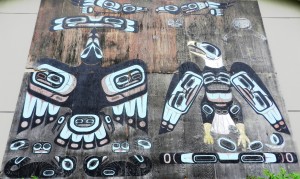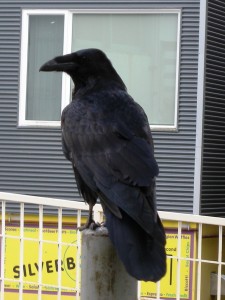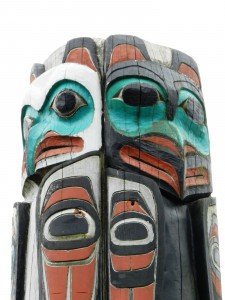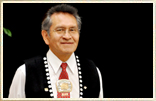» posted on Wednesday, July 18th, 2012 by Linda Lou Burton
Raven and Eagle
 Linda Burton posting from Juneau, Alaska – “Gajaa, gajaa,” said Raven. He was flying over the ocean during The Great Flood looking for a safe place to land. After a while he spotted a small island. So goes the Tlingit story of the beginning of the earth. Many Tlingit stories and legends parallel the Bible, portraying Raven as the possessor of great spiritual powers, sometimes as the Creator, sometimes as the Trickster. Grandson Sam and I are standing at the corner of Willoughby and Village Street in Juneau, reading the sign posted in front of the now fading wall mural designed by Tommy Jimmie Sr and painted by Ed Kunz Sr and Ed Kunz Jr in the late 1970’s. The two figures at the top, Raven and Eagle, represent the two halves of the Auke Tribe. Raven has a cloud in his mouth representing the heavens; Eagle is lifting a dying man to the heavens. Sea otters, spirits and faces are guiding the man to the other side. “Gajaa” means the man is wished a safe place to land. A big black raven is perched on the fence post beside us; we’ve noticed them flying around our hotel and following us everywhere we walk. Is Raven guiding us? Or is it just a pesky bird?
Linda Burton posting from Juneau, Alaska – “Gajaa, gajaa,” said Raven. He was flying over the ocean during The Great Flood looking for a safe place to land. After a while he spotted a small island. So goes the Tlingit story of the beginning of the earth. Many Tlingit stories and legends parallel the Bible, portraying Raven as the possessor of great spiritual powers, sometimes as the Creator, sometimes as the Trickster. Grandson Sam and I are standing at the corner of Willoughby and Village Street in Juneau, reading the sign posted in front of the now fading wall mural designed by Tommy Jimmie Sr and painted by Ed Kunz Sr and Ed Kunz Jr in the late 1970’s. The two figures at the top, Raven and Eagle, represent the two halves of the Auke Tribe. Raven has a cloud in his mouth representing the heavens; Eagle is lifting a dying man to the heavens. Sea otters, spirits and faces are guiding the man to the other side. “Gajaa” means the man is wished a safe place to land. A big black raven is perched on the fence post beside us; we’ve noticed them flying around our hotel and following us everywhere we walk. Is Raven guiding us? Or is it just a pesky bird?
 The PBS Nature Channel has a lot of information about ravens, considered one of the most intelligent of birds. Members of the crow family, these all-black birds are found everywhere in the northern hemisphere and can live in the harshest of conditions. Their image as a trickster comes from their ability to take advantage of another’s efforts to get a meal they couldn’t get on their own. We watched a video of a raven spotting a fishing line left unattended, and pulling it in to grab the fish! (The annoyed fisherman finally caught on.)
The PBS Nature Channel has a lot of information about ravens, considered one of the most intelligent of birds. Members of the crow family, these all-black birds are found everywhere in the northern hemisphere and can live in the harshest of conditions. Their image as a trickster comes from their ability to take advantage of another’s efforts to get a meal they couldn’t get on their own. We watched a video of a raven spotting a fishing line left unattended, and pulling it in to grab the fish! (The annoyed fisherman finally caught on.)
As the sign on Village Street points out, ravens have an image as birds of both life and death. Who hasn’t shivered at the reading of Edgar Allen Poe’s poem – there’s the raven, rapping at the chamber door, sitting on the bust of Pallas, repeating only one word in answer to the questions: nevermore.
 But back to the ravens of Juneau, Alaska, and the legends of the Auke Tribe. The Auke Tribe of the Tlingit Indians was the first to settle in what came to be Juneau. The Tlingit people have two moieties, or descent groups, in their society, Ravens and Eagles. Each clan has its own history, songs and totems. Ravens and Eagles may marry, but, I’ve been told by many residents I have met, they may not marry outside the tribe. The mural on Village Street is bordered by totem poles telling more about Raven and Eagle; Raven Pole depicts the much-told story of Raven bringing light to the world; Eagle Pole honors the Eagle clan with a display of crests. Raven and Eagle are evident all over the city, such as at the Mt Roberts Tramway. One of the tram cars is Raven, the other is Eagle. And the excellent documentary you can see at the top tells more of Tlingit legend and
But back to the ravens of Juneau, Alaska, and the legends of the Auke Tribe. The Auke Tribe of the Tlingit Indians was the first to settle in what came to be Juneau. The Tlingit people have two moieties, or descent groups, in their society, Ravens and Eagles. Each clan has its own history, songs and totems. Ravens and Eagles may marry, but, I’ve been told by many residents I have met, they may not marry outside the tribe. The mural on Village Street is bordered by totem poles telling more about Raven and Eagle; Raven Pole depicts the much-told story of Raven bringing light to the world; Eagle Pole honors the Eagle clan with a display of crests. Raven and Eagle are evident all over the city, such as at the Mt Roberts Tramway. One of the tram cars is Raven, the other is Eagle. And the excellent documentary you can see at the top tells more of Tlingit legend and  history, including a lesson in the Tlingit language. (Gunalcheesh is thank you.)
history, including a lesson in the Tlingit language. (Gunalcheesh is thank you.)
Juneau is headquarters for the Central Council of the Tlingit and Haida Indian Tribes of Alaska, a tribal government representing more than 28,000 Tlingit and Haida Indians worldwide. A sovereign entity, the Central Council has a government-to-government relationship with the United States. Edward K Thomas, a Raven of the Tlingit Tribe, currently serves as Council President. Holding a Master’s degree in Education Administration from Pennsylvania State University, he is responsible for operations administration of the Tribe and oversees 200 employees; he manages an operating budget of $27 million and a tribal fund investment of $8 million. 
An interesting parallel it seems; Raven continuing to guide.
About the Central Council of the Tlingit and Haida Indian Tribes of Alaska http://www.ccthita.org/index.html
PBS information about ravens http://www.pbs.org/wnet/nature/episodes/ravens/introduction/1506/
